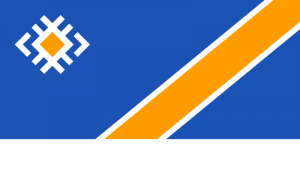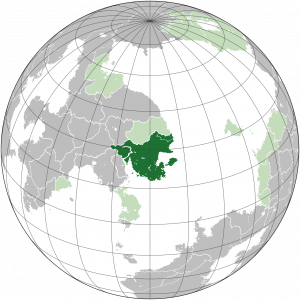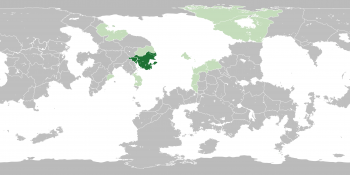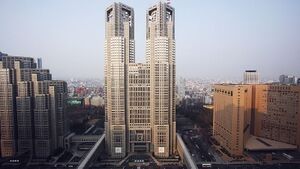Difference between revisions of "Cadenza"
m |
m |
||
| Line 33: | Line 33: | ||
|population_census = 70,498,276 <!-- Your official amount of people by census ---> | |population_census = 70,498,276 <!-- Your official amount of people by census ---> | ||
|population_census_year = 2020 | |population_census_year = 2020 | ||
| − | |population_density_km2 = {{#expr:(70700000/ | + | |population_density_km2 = {{#expr:(70700000/3174098 round 2)}} <!-- Your population divided by your area. Using last census, not estimate. ---> |
|population_density_sq_mi = <!--Do not remove this row, it works automatically!--> | |population_density_sq_mi = <!--Do not remove this row, it works automatically!--> | ||
|population_density_rank = 8th <!-- Ranks are usually handled by Admins, so leave blank ---> | |population_density_rank = 8th <!-- Ranks are usually handled by Admins, so leave blank ---> | ||
Revision as of 07:50, 4 April 2021
The Democratic Republic of Cadenza Loi Dermos Republiq Cadenzae | |
|---|---|
|
Flag | |
Anthem: "To Cadenza Our Honor" | |
| Capital | Cadenza City |
| Official languages |
|
| Ethnic groups |
|
| Demonym(s) | Cadenzan |
| Government | Constitutional Democratic Republic |
| Daniel Kerman | |
| Michino Kjanki | |
| Larrin Klaskon | |
| Oleophon Kerman | |
| Legislature | House of Councils |
| Indedpendence from Orbs | |
• Fall of the Orbik Empire | 1952 |
• Liberty Day | 1962 |
| Area | |
• Total | 3,174,098 km2 (1,225,526 sq mi) (2) |
• Water (%) | 1 |
| Population | |
• April 2021 estimate | |
• 2020 census | 70,498,276 |
• Density | 22.27/km2 (57.7/sq mi) (8th) |
| GDP (nominal) | 2021 estimate |
• Total | |
• Per capita | |
| Gini (2021) | medium · N/A |
| HDI (2020) | very high · N/A |
| Currency | The Cadzen (CAD) |
| Date format | mm/dd/yyyy |
| Driving side | right |
| Calling code | +14 |
| Internet TLD | .ca |
Cadenza (Cadenzan: Cadenza [Cuh-DEN-zah]), officially The Democratic Republic of Cadenza, is a Democratic Republic on the east coast of Mlorba. Its entire eastern border is bordered by the Nuntic Sea, while it borders the North Mlorba Coalition in the north and west. Cadenza is the sixth-largest nation in terms of area on Kerbin, covering 3,241,134.27 square kilometers. Cadenza has a population of approximately 70.7 million and is comprised of 10 states. The majority of Cadenza's population lives below the Utinon mountains in southern Cadenza, whereas northern Cadenza is more sparsely populated and more industrial in nature. Cadenza was part of the Mlorbik Empire, and once collapsed Orbs. Under the extreme pressure of a fallen nation, many small and extremist nations formed in Morlba, with Cadenza being the largest territory. Once a fascist stratocracy, Cadenza had a violent formation and early few years. Power changed hands repeatedly but eventually was settled down to Ulker Froser Cadenzae, one of the most well-known rulers in Cadenzan history. 10 years later after a series of bloody revolutions and strikes, Cadenza was eventually formed into a democracy, establishing the systems still mostly in place today. Today, Cadenza's population has remained relatively small for its size but has an impressive GDP of 1.55 Trillion NSD and a GDPPC of 21,923 NSD. The current president of Cadenza is Daniel Kerman. Cadenza maintains a medium-sized armed force, with most equipment and materials backed by Serria. Cadenza has an immense manufacturing sector and is one of the primary manufacturing centers for Serrian export due to its close proximity and land availability.
Etymology
Cadenza was first given its name at the hand of its first major ruler, Froser Cadenzae. Before Cadenzae took over the region and unified its borders, the general area of Cadenza was often referred to as "The Free Land" or "The Land of the Free".
History
Ancient History
Around 187 BCE is when the first Kerbals settled in the region of southern Cadenza. Over the next ~700 years, the Orbiks settled in and dominated the region, setting up primitive civilization and setting for the basis of civilization. The formation of the Mlorbik Empire in 750 sparked a new age for the region, as within 100 years the entire region was no longer considered Orbik and instead a part of the Mlorbik Empire. This empire was in place for around 1000 years and served as a time of prosperity for the region. Due to the location of the region within the Empire, the population was majority Orbik and was fiercely loyal to the Empire.
Fall of the Empire and the Formation of Orbs
Near the end of the Empire's existence, its flaws started becoming more and more apparent. The Mlorbik Empire was an absolute monarchy. This style of government was quickly becoming unpopular within the nations and empires that had a monarchy. Opposing ideologies started rising up in larger and larger numbers, and eventually, the Empire fell. Following the Empire's falling, the entire continent of Mlorba was faced with anarchy. However, within the next few years, the region stabilized into the nation Orbs, smaller than the Mlorbik Empire was, but still immensely large. Orbs was formed up of many small states, including Corza (the southern area of modern-day Cadenza), Orba, and Blorba. Orbs was a fascist government, which was quickly adopted by the state of Corza into near extremism. This would help develop the ideologies and practices that soon became the downfall of Orbs.
Fall of Orbs and the Formation of Cadenza
After 250 years of Orbs being a relatively successful, if not mildly anarchic country, problems started to arise. Abuses of the Blorbik people became more and more prominent, often making the newspapers and TV news reports and becoming a common tale among the people in Blorba and other states of Orbs. Between this and the steadily declining economic state, a revolution, bloodier than that of the fall of the Mlorbik Empire took place. In 1952, Orbs finally fell, and once again Mlorba fell into anarchy. The first country to stabilize itself from this anarchy was Blorbs, taking up the original state of Blorba and the rest of the peninsula it is still located on today. Then followed by Cadenza, initially a warlord state in its first year, it was eventually settled into a fascist stratocracy by Ulker Froser Cadenzae.
Cadenza's Early years and Final Revolution
Cadenza was ruled under Froser Cadenzae from 1953 to 1962 when he was ousted by the Final Revolution and killed in his bunker-style house. During this time period, Cadenza was held under an iron fist, and was forced to adhere to strict laws and regulations, and adhere to the labor of a country with an ever-increasing need for a strong military of its own. During this time was when much of Cadenza's early military was developed, however not without controversy. Labor laws were nearly non-existent in early Cadenza, which was cause for some uprising. In June 1956, April 1957, January 1959, and November 1961, a raid on the Khapitol took place. All attempts failed. It was only after a major pay delay and cut that led to the military's uprising against the government, leading to the Final Revolution, ending on the 3rd of September 1962. Shortly after this revolution, the shelter-seeking moderate politicians formed up and created the House of Councils, initially formed up of 5 Councils. They wrote the document "Liberty of our Nation" and drafted the constitution of Cadenza. Many of the military leaders became the early politicians of this House, leading to the development of a finally stable Cadenza. This style of government is still in place today. September the 3rd is a national holiday, Liberty Day.
Modernization and Prosperity
One of the first acts of the newborn Cadenza after the Liberty of our Nation and the constitution was the Modernization Doctrine. As the country was running on severely outdated tech at the time, the country wrote up a doctrine pledging itself to never cease the modernization of its cities, infrastructure, roads, and military. This is exemplified in the wild variety of modern and historic buildings in Cadenza's cities, as well as the Military Modernization reforms of 1983 and 2005. Cadenza's economy has flourished, establishing trade with its nearby nations, mainly the Serrian Archipelago and its beneficiaries. In 2019, the Serrian Economic Cooperation Treaty was signed, securing and encouraging trade between its member nations, for the stability and prosperity of each of the member nations.
Geography
Cadenza is dominated by flat and fertile plains in the south below the dividing Utinon Mountains, and a massive plain of steppes in the north. Near the northeast coast, a strip of rough wasteland is present, providing a perfect place for factory work and other industry such as mining. South of the Utinon mountains can almost be described as a tropical climate, yet a moderate tropical climate at best. The coastline is dotted with small lakes and inlets, as the elevation is immensely flat in the region. The Gulf of Cadenza is home to the nation's capital, Cadenza City, and the Khapitol. It's connected to the Dolphik Sea by the Cadenzan Canal. The southern coast is almost entirely beach and is home to many tourist attractions, such as the famous Kenti Beach region. North of the Utinon mountains the climate turns cold very quickly, and is home to immense snowfalls in the far north during winter seasons. The steppes region west of the wasteland is largely uninhabited compared to the densely packed south.
Demographics
Population
The population of Cadenza is over 89% Orbik, with the other 11% being mixed minorities from other parts of Mlorbs and other countries. The majority of the population (about 68%) lives in the ever-changing south of Cadenza, whereas the remaining 32% of people live north of the Utinon Mountains. Cadenza's largest city is Cadenza City, which is home to over 4 million citizens. It's located in the Gulf of Cadenza and is the prime trade hub of the nation.
Language
The language of Cadenza is comprised of 2 dialects, Cadenzan Orbik on the south side of the Utinon Mountains, and Oztek Orbik in the North. Both are nearly identical in terms of syntax, grammar, and sentence structure, with only minor differences in pronunciation and spelling. It evolved from the original Orbik and therefore is very compatible with languages spoken by other countries on Mlorba
Government
The government of Cadenza is made up of 3 branches. The Executive branch, the House of Councils, and the Judiciary Branch. The House of Councils is made up of 14 councils, each chaired by a presidential-chosen representative and 6 members, all led by the Chairman of the House. The House is responsible for the creation reform, and enactment of laws and acts, as well as overseeing their enforcement. The House resides in a massive double tower structure in the middle of Cadenza City. The executive branch is led by the President and seconded by the Vice President. The responsibility of the Executive branch is to sign off on laws put forth by the House and to lead the country in war, alongside the Secretary of War. The Judiciary branch is led by the Supreme Judge and forms the Supreme Hall, the last step in the court system of Cadenza. The Supreme Judge, along with 8 other members make up the Judiciary branch, which is responsible for the judgment of laws deemed unconstitutional.
Foreign Relations and Military
Cadenza is a relatively neutral country when it comes to world conflict, but is very active when it comes to world trade. It is allied with far more countries than it is adversaries with. Notable are the 9 nations of the Serrian Economic Cooperation Treaty, of which Cadenza maintains great standing with. Cadenza's main enemies have all been on the continent of Mlorba, the most notorious of which is Heruland/The North Mlorba Coalition, though they have all been eliminated as a threat due to CDN intervention.
Cadenza's military has 3 branches; the Army of Cadenza, the Cadenzan Air Force, and the Cadenzan Navy. the Army of Cadenza mainly operates the CML.3 'Defender' battle tank, as well as numerous other types of vehicles such as the CSL.2, Volpe, Rendestaggio II, and Varno, making up a strong army. the Cadenzan Air Force is composed of 488 aircraft, ranging from fighters and fighter attackers to electronic warfare aircraft, and bombers. The CAF trains its pilots rigorously in many aspects of flying and combat, and they are a formidable opponent to encounter in the skies. The Cadenzan Navy operates 62 different ships, many of them being small support/supply ships. The flagship of the Cadenza Navy is a Serrian PN.5, a small carrier that can launch and land a variety of fighters and STOVL aircraft.
Economy
The Cadenzan Economy is almost entirely based around global trade with the partners in the Serrian Economic Cooperation Treaty. It houses a large number of factories to create Serrian military vehicles, ships, and airplanes, as well as other consumer and luxury goods. Cadenza's market-style economy has led to a huge growth in the number of Cadenzan-borne companies, some of which have gone on to become international businesses with a booming share. In 2020, Cadenza joined the International Trade Sphere, further broadening its position within the global trade scene. Joining the ITS helped further remove hassles of trade between nations, especially the member nations not already economically allied with Cadenza through the SECT. While the organization's real-world effect on trade with Cadenza is debatable, the pact has provided various other military and corporate benefits to the country, a good deal of which are classified.
Article is unfinished



